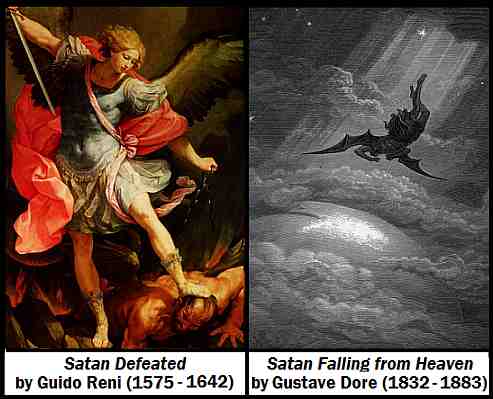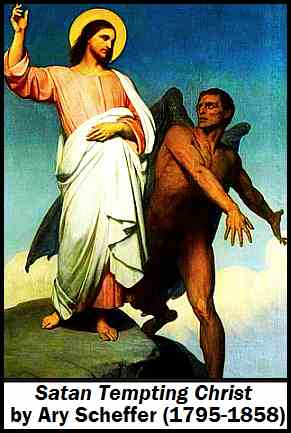
The Devil
The Devil is known by many names, including Satan, Lucifer, Mephistopheles, Beelzebub, the Evil One, and the Prince of Darkness. According to ancient scriptures, he was originally one of God's foremost angels. But pride and envy caused him to revolt against God, and he was thrown out of Heaven. Despite this humiliation he remained defiant, and sought revenge by trying to tempt people away from God and convert them into his own worshipers.
One of his favorite ways to tempt people is to give them fantasies of future wealth. He knows that many people will eventually be overcome by greed and turn to dishonest methods to achieve their goals. As a master of deceit, he can even entrap people who think they have rejected him.
Because of his evil nature, artists usually depict him as a loathsome repulsive creature. Paintings often show him with horns, fangs, hooves, scaly skin, red eyes, and a tail. Since he was originally an angel, he is sometimes given wings. Medieval artists often gave him the legs and hindquarters of a goat. But no one knows what he really looks like, because he can disguise himself by magically taking on any appearance he chooses, or even by fading into invisibility. In fact many people think of him as a supernatural spirit rather than a physical being.
People often ask why God allows him to pursue his evil activities. One possible answer is that God doesn't have full control over his former angel. Another answer is that God permits him to tempt people in order to test their faith and devotion. But the first answer implies that God isn't truly all-powerful. And the second answer makes God the ultimate tempter, and the ultimate cause of much of the pain and suffering that people experience.
The Devil is often identified with the serpent that tempted Eve in the Garden of Eden. Later in the Old Testament he appears in the Book of Job, where he is an angel called Satan living at the Court of Heaven, but slyly stirring up trouble. By the period of the New Testament he has been thrown out of heaven, and is showing himself to be the true Evil One.
The Devil Tempts Jesus
His evil nature is depicted very clearly in the gospels, especially in the famous temptation of Jesus. As described in Matthew 4:1-11, this temptation took place in a wilderness area where Jesus had gone to meditate and fast. As he meditated, Satan approached him and challenged him to prove his powers by turning stones into bread and by leaping from the roof of the Temple in Jerusalem. Of course Jesus didn't need to prove anything, and he refused both challenges. Then, for the ultimate temptation (Matthew 4:8-10):
The devil took him to a very high mountain and showed him all the kingdoms of the world and their splendor. "All this I will give you," he said, "if you will fall down and worship me."
Jesus said to him, "Away from me Satan! For it is written, Worship the Lord your God, and serve him only."
Note: The image shows the Devil tempting Jesus on the top of the mountain.
When Jesus began his ministry, he attracted a lot of attention through his ability to expel demons. At that time the behavior of mentally-ill people was often attributed to evil spirits who had taken over their bodies under the direction of the devil. Such people were said to be possessed by demons. The only way to cure the condition was to expel the demons from the person's body.
In one such cure, described in Luke 8:26-40, Jesus needed to expel a large number of demons from a single man. This man, who called himself Legion, wore no clothes and lived in tombs. Local citizens had bound him in chains and fetters, but he had broken free and escaped. When Jesus ordered the demons to leave his body, they tried to save themselves by entering the bodies of some nearby pigs. But the pigs immediately ran into a lake and drowned.
The Witch Hunts
As Christianity spread to new areas, belief in the Devil went with it. During the Middle Ages, European artists often depicted him as a half-man half-beast, but in popular stories he could disguise himself as a black cat or a toad. Some stories even described personal encounters with him. For example, Saint Dunstan, a tenth-century bishop of Canterbury, reported that he was in his workshop making a metal chalice when Satan suddenly appeared in front of him. To defend himself, he seized the intruder's nose with a pair of red-hot tongs.
The great Protestant reformer Martin Luther reported dozens of encounters with Satan. On one occasion he threw an ink pot at the loathsome fiend.
Fear of the Devil was especially widespread during the witch hunts of the sixteenth and seventeenth centuries. During this period thousands of people were accused of being his helpers, and many of them were tortured and killed.
A witch hunt would often start when something bad happened in a community, and people looked for someone to blame. It was thought that witches and warlocks, using powers given to them by Satan, could cast magic spells which would bring misfortune to others. Suspicion would usually focus on an unpopular or reclusive individual, or someone who exhibited odd behavior. Accusations against such a person were often checked by examining the suspect's body for a suspicious-looking blemish, mole, or scar called a Devil's Mark. Such a mark could nearly always be found, but if additional proof was desired, a confession could usually be obtained by torture. The usual punishment was to burn the victim to death.
During this period numerous stories about witches and warlocks circulated through the population. The stories could involve secret midnight meetings, worship at the feet of the Devil, sexual orgies and perversions, sacrificed babies, and blood drinking. Sometimes there were rumors that a particular woman had become Satan's lover.
Some people are attracted to the dark side of life that the Devil represents. Secret devil worship has long existed in some communities, and there has been a resurgence in modern times.
Satan is sometimes associated with occurrences of stigmata. These are mysterious markings or wounds which resemble the wounds suffered by Jesus. In most cases they appear on very pious individuals and are regarded as a divine sign of mystical contact with God. But occasionally stigmata appear on people who aren't considered to be pious, and these false occurrences are often attributed to Satan.
Does the Devil Really Exist?
Many modern Christians doubt that Satan really exists. They say that biblical stories such as the temptation of Jesus are allegories, and that Jesus didn't actually expel real demons.
But some people believe that everything in the Bible is literally true, including the reality of the Devil. Many of these people think that they can see his influence in modern society, and take this as further proof of his existence.
Other Topics
Note: The pictures of the devil on this page are public domain images taken from the WikiMedia Commons Website. The original images have been cropped and captions have been added.
Contact Email




